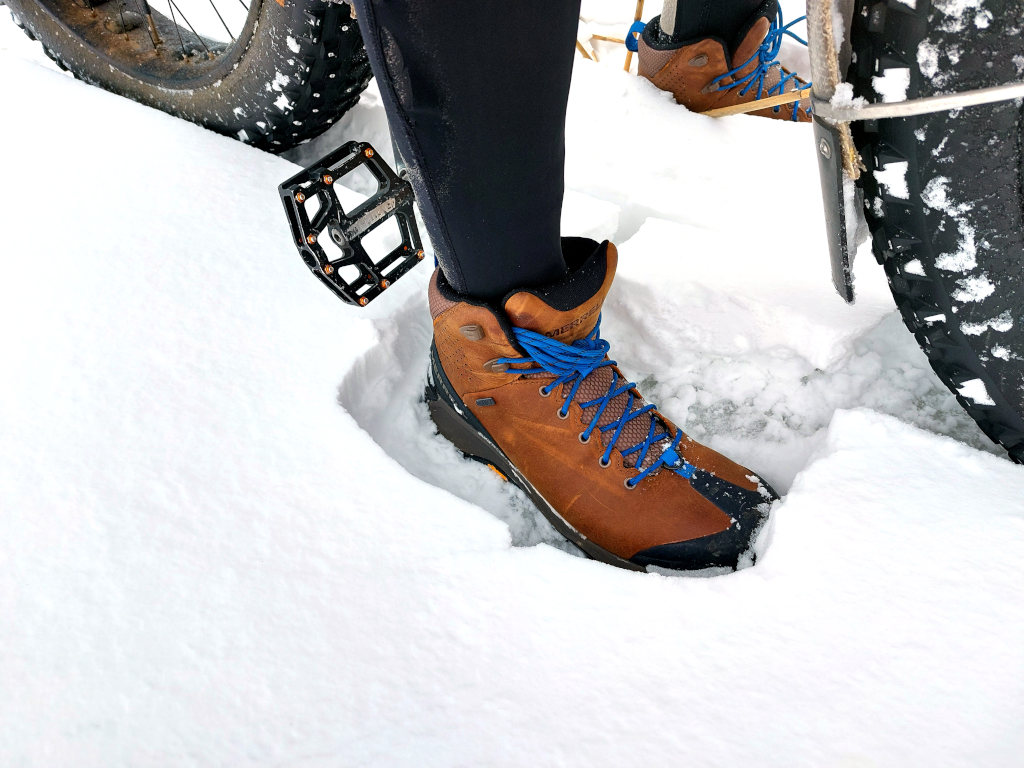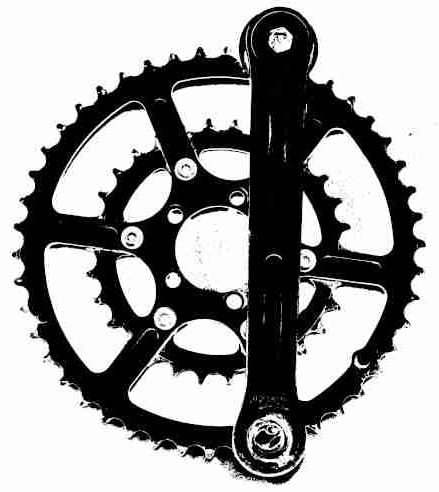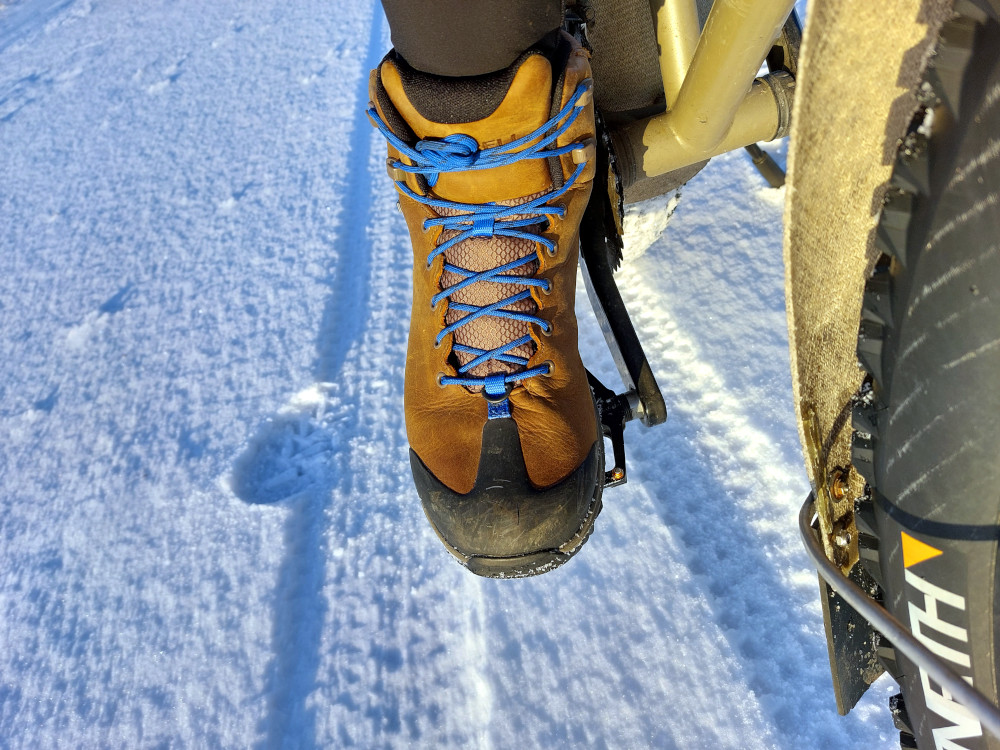Which Winter Boots for Flat Pedals (MTB/Fatbike)?
Most people prefer to ride with flat pedals in challenging winter conditions, be it fat or MTB. This creates a shoe problem: your regular clipless cycling shoes are out. You now need to pick a shoe that works well with flat pedals and can take the winter conditions.
So which shoes should you use? Do you really need some of the $300+ biking-specific winter boots to survive on the trail?
The truth is that biking in winter is possible with any boots that are waterproof and warm enough; having some shaft and a stiff relatively low-profile sole also helps. While purpose-made flat-pedal winter cycling boots are optimal, most regular winter hiking boots work too. Rubber boots are the best choice in very wet terrain, whereas cycling shoes with covers are OK in dry conditions and on clipless pedals.
I will next give my view on what’s needed from a winter biking boot and how different shoes stack up!

Winter biking boot specs
1 Waterproofing
Winter biking boots should be waterproof, particularly from below. You will inevitable have to lay your foot into puddles, slush, mud, or even ankle-deep water. Getting your feet wet in cold conditions is the last thing you want.
(Waterproofing is more important than insulation, which you can improve with thicker socks.)
2 Insulation
Insulation in the boot is essential for many for winter biking. Spacious waterproof shoes and multiple pairs of socks do work, but insulation in the boot itself often helps a lot.
As a rule, the longer the ride and the lower the tempo, the colder your feet. Long and relaxed fatbike rides are probably the worst here.
Note that how easy you get cold feet varies from person to another – adjust the insulation to your circulation. Personally, I have quite hot feet and must actually avoid boots that are too warm.
3 Shaft
Boots for winter biking should have some shaft. The main reasons are to insulate the ankle and to prevent water and snow ingress.
Choose shaft height according to the conditions. Ankle high boots are enough for low snow and relatively dry terrain; medium rise boots at around 6″ are enough for most conditions; very deep snow, mud or water call for 10″ or more.

4 Stiff sole
Winter biking boots should have a stiff sole to reduce foot fatique. In all cycling, a reasonably stiff sole provides better pedaling ergonomics than a flexible one.
Hiking boots are usually stiff enough, but rubber boots and some walking boots may be uncomfortable due to the flexible sole.
Boot roundup

1 “Winter Biking Boots”: Optimized
Winter-specific cycling boots are expensive but otherwise the optimal choice: waterproof, insulating, tall enough and with a stiff sole. The outer sole lugs are usually low-profile which helps them sit easy on all flat pedals.
Biking-oriented winter boot models are available from a few manufacturers, most notably 45NRTH (the Wølfgar and Wölvhammer).
Many of these biking boots also take cleats and allow you to use them with Shimano SPD or other clipless pedals, should you prefer to ride with them.
| Pros: | Cons: |
|---|---|
| + Warm + Waterproof + Stiff sole + Non-snag tightening + Perfect with flat pedals + Cleats option | – Expensive |
2 Winter hiking boots: Good enough
Most winter hiking boots are a decent all-around choice for bike riding: waterproof and warm enough, with a 6″ or taller shaft. The sole is also typically quite stiff.
Winter hiking boots offer pretty much what purpose-made biking boots do, but at a lower price – often you actually already own a pair.
Winter hiking boots do have a few possible drawbacks. First, hiking boots have long laces and lace hooks which may interfere with the chainring and front derailleur. Hiking boots often have heavy rubber lug patterns, some of which may not mesh well with your pedals.
NB. When biking with hiking boots, be sure to lace the boots all the way and tuck in the laces.
| Pros: | Cons: |
|---|---|
| + Warm + Waterproof + Stiff sole + OK with flat pedals | – Laces&hooks may catch drivetrain |
3 Rubber boots: Wet terrain
Rubber boots are a good candidate for winter biking in wet conditions: certainly waterproof, tall shaft (up to 20″) and affordable. Many rubber boot models also have some insulation integrated, and should always fit a thick wool sock.
However, rubber boots often have too much shaft, and tend to feel clumsy and restrictive on the bike. Many also have too flexible soles for best on-pedal comfort.
You may still find some shorter, stiffer and insulated rubber boot models that work really well on the bike.
I have chosen rubber boots (18″ shaft) for really wet fatbiking in boggy terrain, along shoreline or on sea ice very early or very late in the season. You can get to wheel hub depth with dry feet!
| Pros: | Cons: |
|---|---|
| + Very waterproof + Warm (w. thick socks) + Best for VERY wet terrain | – Tall models clumsy |
4 Cycling shoes & covers: Some work
Some flat-compatible regular cycling shoes with shoe covers are a viable option for winter biking in a dry environment.
There are some MTB-oriented clipless cycling shoe models with flat soles that actually work with flat pedals (after you remove the cleat). When paired with fitting a shoe cover, such shoes become a viable boot option for winter biking.
The cycling shoe & shoe cover combination is warm enough for moderate winter conditions and waterproof from above (rain). I have ridden this combo down to -4°F (-20°C), and in pouring rain, without any issues.
The main drawback of cycling shoes and shoe covers is that most are not waterproof from below – step into the shallowest of puddles and water will seep in through cleat holes or the sides. A second challenge is the shoe cover sole: you’ll need to pick a reinforced model that can take the grind of the flat pedal studs.
| Pros: | Cons: |
|---|---|
| + Rainproof + Warm + Stiff sole + SPD pedals | – Not for wet terrain – Not for flat pedals |
Parting thoughts: Flat or clipless for winter?
The consensus among cyclists is that flat pedals work better in deep snow, relaxed pace, dirty and variable condition riding. Flats are more practical and safe when you need to put your foot down often, and more resistant to dirt and ice.
Clipless pedals become more competitive in easier terrain and faster-paced riding. At higher speeds, you want to keep your feet on the pedals. Being able to clip in helps in this.

